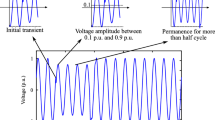Abstract
This paper proposes a new approach capable of locating the voltage sag source side in the power grid based on power-flow behavior at the common coupling point. Measuring the phase voltages and the phase currents flowing at the interested systems interconnection point, the proposed approach is a suitable solution to locate the side of symmetrical and asymmetrical voltage sag source using a set of Boolean logics. A comparative analysis is performed between the best distance relay fault locator method and the proposed approach after being assessed through a simulated case study in a Brazilian utility and industrial systems. Each simulated system has a distributed generation, active loads and power flowing at any directions. The novelty proposal is justified by the simplicity and robustness. Theoretical analysis and simulation have verified its effectiveness.









Similar content being viewed by others
References
de Carvalho Filho, J. M., Leborgne, R. C., de Oliveira, T. C., de Abreu, J. P. G., & de Oliveira, J. F. (2008). Voltage sags assessment based on fault characteristics. In 13th International Conference on Harmonics and Quality of Power, 2008 (ICHQP 2008), pp. 1–6, 28 Sept. 2008–1 Oct. 2008.
Hamzah, N., Mohamed, A., & Hussain, A. (2004). A new approach to locate the voltage sag source using real current component. Electric Power Systems Research, 72, 113–123.
IEEE Recommended. (2009). IEEE recommended practice for monitoring electric power quality. In IEEE Std 1159-2009 (Revision of IEEE Std 1159-1995), pp. c1–c81, 26 June 2009.
Leborgne, R., Karlsson, D., & Daalder, J. (2006). Voltage sagsource location methods performance under symmetrical and asymmetrical fault conditions. In Transmission Distribution Conference and Exposition: Latin America, 2006, TDC 06. IEEE/PES, Caracas, Venezuela, Aug. 2006.
Lee, K., Venkataramanan, G., & Jahns, T. M. (2008). Modeling effects of voltage unbalances in industrial distribution systems with adjustable-speed drives. IEEE Transactions on Industry Applications, 44(5), 1322–1332.
Li, C., Tayjasanant, T., Xu, W., & Liu, X. (2003). Method for voltage-sag-source detection by investigating slope of the system trajectory. IEEE Proceedings—Generation, Transmission and Distribution, 150, 367–372.
Makaliki, R., & Leborgne, R. C. (2007). Voltage sag source location: Case study in Zambian grid. In IEEE Power Engineering Society Conference and Exposition in Africa, 2007 (PowerAfrica ’07), pp. 1–5, 16–20 July 2007.
Masetti, C. (2010). Revision of European Standard EN 50160 on power quality: Reasons and solutions. In 14th International Conference on Harmonics and Quality of Power, 2010 (ICHQP 2010), pp. 1–7, 26–29 Sept. 2010.
Milanovic, J. V., & Gupta, C. P. (2006a). Probabilistic assessment of financial losses due to interruptions and voltage sags-part I: The methodology. IEEE Transactions on Power Delivery, 21(2), 918–924.
Milanovic, J. V., & Gupta, C. P. (2006b). Probabilistic assessment of financial losses due to interruptions and voltage sags—Part II: Practical implementation. IEEE Transactions on Power Delivery, 21(2), 925–932.
Oliveira Passos, F., de Carvalho Filho, J. M., & da Silveira, P. M. (2014). Real time digital simulation of utility and industrial co-generation system interconnection—Evaluating a new approach of voltage sag source locator. In IEEE 16th International Conference on Harmonics and Quality of Power, 2014 (ICHQP 2014), pp. 14–18, 25–28 May 2014.
Parsons, A., Grady, W., Powers, E., & Soward, J. (2000). A direction finder for power quality disturbances based upon disturbance power and energy. IEEE Transactions on Power Delivery, 15, 1081–1086.
Pedra, J., Corcoles, F., & Suelves, F. J. (2005). Effects of balanced and unbalanced voltage sags on VSI-fed adjustable-speed drives. IEEE Transactions on Power Delivery, 20(1), 224–233.
Polajzer, B., Rtumberger, G., & Dolinar, D. (2015). Instantaneous positive-sequence current applied for detecting voltage sag sources. IET Generation, Transmission and Distribution, 9(4), 319–327.
Pradhan, A., & Routray, A. (2005). Applying distance relay for voltage sag source detection. IEEE Transactions on Power Delivery, 20, 529–531.
Tayjasanant, T., Li, C., & Xu, W. (2005). A resistance sign-based method for voltage sag source detection. IEEE Transactions on Power Delivery, 20, 2544–2551.
Yonghai, X., Qianqian, G., Yilin, Y., Shun, T., & Xiangning, X. (2012). Research of method for voltage sag source location in power system. In IEEE 15th International Conference on Harmonics and Quality of Power (ICHQP 2012), pp. 816–822, 17–20 June 2012.
Acknowledgments
The authors acknowledge the financial support from FAPEMIG, CAPES, CNPq, INERGE and CERIn for sponsoring this research.
Author information
Authors and Affiliations
Corresponding author
Rights and permissions
About this article
Cite this article
Passos, F.O., de Carvalho Filho, J.M., Leborgne, R.C. et al. An Alternative Approach to Locating Voltage Sag Source Side at the Point of Common Coupling Based on Power-Flow Information. J Control Autom Electr Syst 26, 579–587 (2015). https://doi.org/10.1007/s40313-015-0199-x
Received:
Revised:
Accepted:
Published:
Issue Date:
DOI: https://doi.org/10.1007/s40313-015-0199-x




